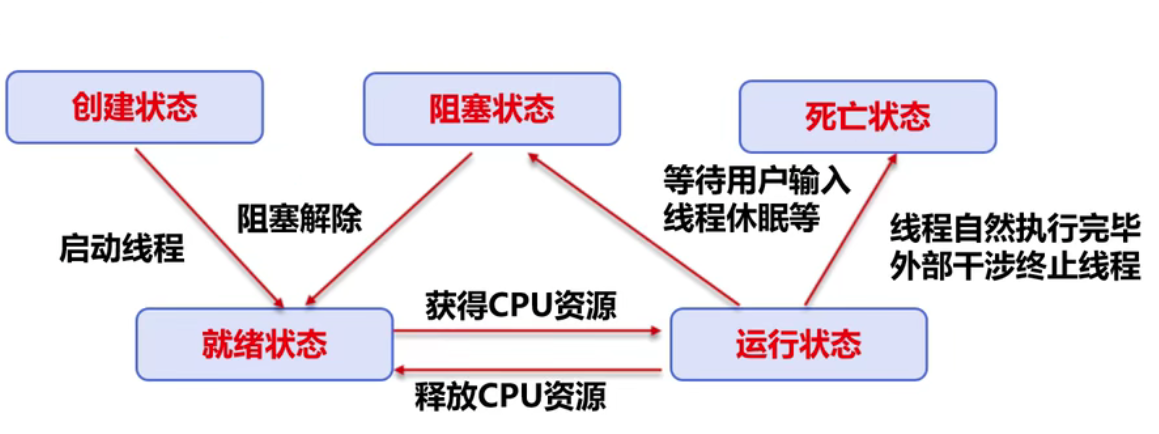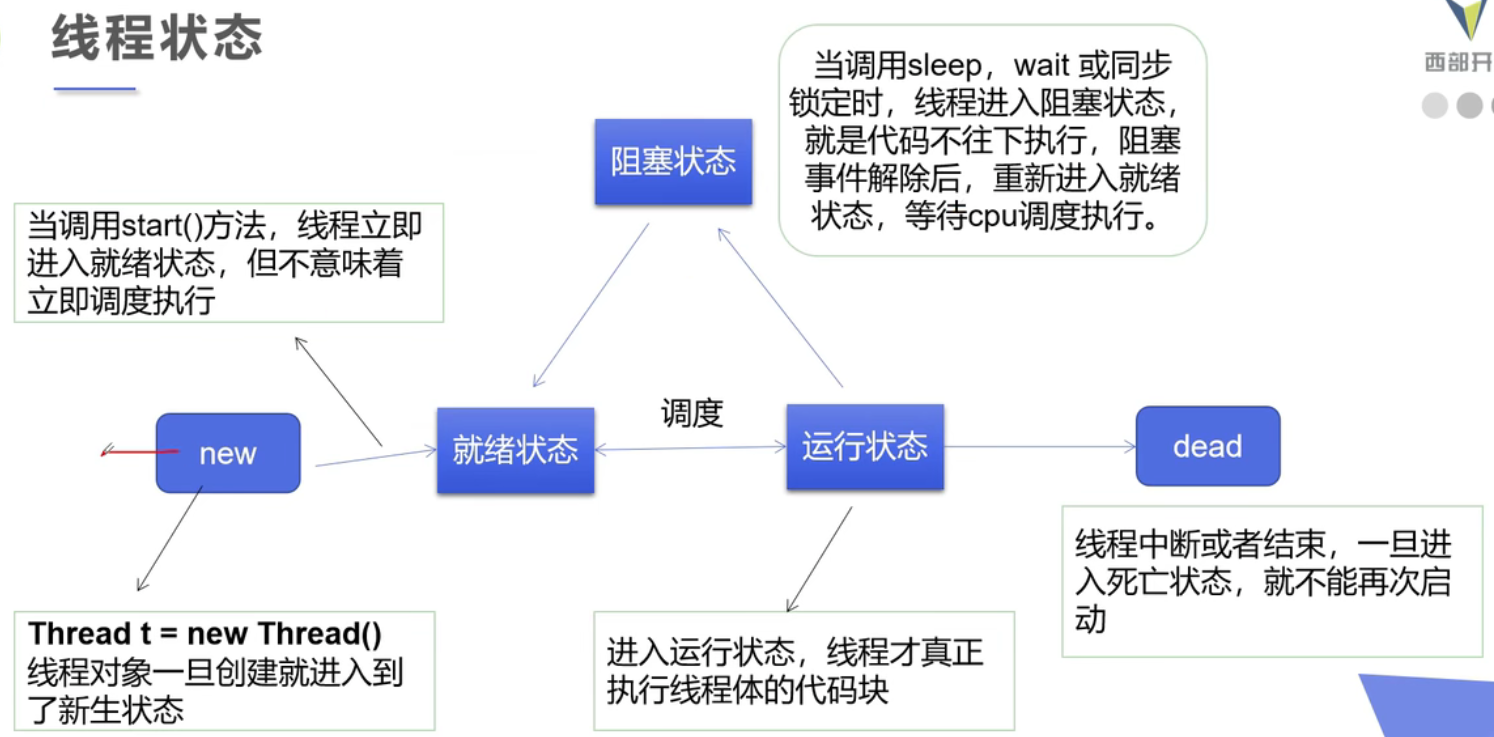多线程
1、线程简介
-
Process与Thread
-
说起进程,就不得不说下程序。程序是指令和数据的有序集合,其本身没有任何运行的含义,是一个静态的概念。
-
而进程则是执行程序的一次执行过程,它是一个动态的概念。是系统资源分配的单位
-
通常在一个进程中可以包含若干个线程,当然一个进程中至少有一个线程,不然没有存在的意义。线程是CPU调度和执行的单位。
-
注意:很多多线程是模拟出来的,真正的多线程是指有多个cpu,即多核,如服务器。如果是模拟出来的多线程,即在一个cpu的情况下,在同一个时间点,cpu只能执行一个代码,以为切换的很快,所以就有同时执行的错觉。
-
-
本章核心概念
-
线程就是独立的执行路径;
-
在程序运行时,即使没有自己创建线程,后台也会有多个线程,如主线程,gc线程;
-
main()称之为主线程,为系统的入口,用于执行整个程序;
-
在一个进程中,如果开辟了多个线程,线程的运行由调度器安排调度,调度器是与操作系统紧密相关的,先后顺序是不能人为的干预的。
-
对同一份资源操作时,会存在资源抢夺的问题,需要加入并发控制;
-
线程会带来额外的开销,如cpu调度时间,并发控制开销。
-
每个线程在自己的工作内存交互,内存控制不当会造成数据不一致。
-
2、线程实现(重点)
Thread、Runnable、Callable
三种创建方式:
1. Thread Class 继承Thread类(重点)
2. Runnable接口 实现Runnable接口(重点)
3. Callable接口 实现Callable接口(了解)
2.1、Thread
-
自定义线程类继承Thread类
-
重写run()方法,编写线程执行体
-
创建线程对象,调用start()方法启动线程
//创建线程方式一:继承Thread类,重写run()方法,调用start开启线程
//总结:注意,线程开启不一定立即执行,由CPU调度执行
public class TestThread1 extends Thread{
我在学习多线程---0
我在学习多线程---1
我在学习多线程---2
我在学习多线程---3
我在学习多线程---4
我在学习多线程---5
我在学习多线程---6
我在学习多线程---7
我在学习多线程---8
我在学习多线程---9
我在学习多线程---10
我在看代码---0
我在看代码---1
我在看代码---2
我在看代码---3
我在学习多线程---11
我在学习多线程---12
我在学习多线程---13
我在学习多线程---14
我在学习多线程---15
我在学习多线程---16
我在学习多线程---17
我在学习多线程---18
我在学习多线程---19
我在学习多线程---20
我在学习多线程---21
我在看代码---4
我在看代码---5
我在看代码---6
我在看代码---7
案例一:多线程实现图片下载
import org.apache.commons.io.FileUtils;
import java.io.File;
import java.io.IOException;
import java.net.URL;
//练习Thread,实现多线程同步下载图片
public class TestThread2 extends Thread {
private String url; //网络图片地址
private String name; //保存的文件名
public TestThread2(String url, String name){
this.url = url;
this.name = name;
}
//下载图片线程的执行体
下载了文件名为:2.jpg
下载了文件名为:1.jpg
下载了文件名为:3.jpg
Process finished with exit code 0
2.2、实现Runnable
-
定义MyRunnable类实现Runnable接口
-
实现run()方法,编写线程执行体
-
创建线程对象,调用start()方法启动线程
//创建线程方式:实现runnable接口,重写run方法,
//执行线程需要丢入runnable接口实现类,调用start方法。
public class TestThread3 implements Runnable{
我在学习多线程---0
我在学习多线程---1
我在学习多线程---2
我在学习多线程---3
我在学习多线程---4
我在学习多线程---5
我在看代码---0
我在看代码---1
我在看代码---2
我在看代码---3
我在看代码---4
我在看代码---5
我在看代码---6
我在看代码---7
我在看代码---8
我在看代码---9
我在看代码---10
我在看代码---11
我在学习多线程---6
我在学习多线程---7
我在学习多线程---8
import org.apache.commons.io.FileUtils;
import java.io.File;
import java.io.IOException;
import java.net.URL;
//练习Thread,实现多线程同步下载图片
public class TestThread2 implements Runnable {
private String url; //网络图片地址
private String name; //保存的文件名
public TestThread2(String url, String name){
this.url = url;
this.name = name;
}
//下载图片线程的执行体
下载了文件名为:1.jpg
下载了文件名为:2.jpg
下载了文件名为:3.jpg
Process finished with exit code 0
小结
-
继承Thread类
-
子类继承Thread类具备多线程能力
-
启动线程:子类对象.start()
-
不建议使用:避免OOP单继承局限性
-
-
实现Runnable接口
-
实现接口Runnable具有多线程能力
-
启动线程:传入目标对象+Thread对象.start()
-
推荐使用:避免单继承局限性,灵活方便,方便同一个对象被多个线程使用
//一份资源
StartThread4 station = new StartThread4();
//多个代理
new Thread(station,"小明").start();
new Thread(station,"老师").start();
new Thread(station,"小红").start();//案例二:
//多个线程同时操作同一个对象
//买火车票的例子
//发现问题:多个线程操作同一个资源的情况下,线程不安全,数据紊乱。例如:老师和小明同时拿了第一张票
public class TestThread4 implements Runnable {
//票数
private int ticketNums = 10;
小明-->拿到了第10票
老师-->拿到了第9票
小红-->拿到了第8票
老师-->拿到了第7票
小明-->拿到了第6票
小红-->拿到了第5票
小明-->拿到了第4票
老师-->拿到了第3票
小红-->拿到了第2票
老师-->拿到了第1票
小明-->拿到了第1票
小红-->拿到了第0票
Process finished with exit code 0案例:龟兔赛跑-Race
-
首先来个赛道距离,然后要离终点越来越近
-
判断比赛是否结束
-
打印出胜利者
-
龟兔赛跑开始
-
故事中是乌龟赢的,兔子需要睡觉,所以我们来模拟兔子睡觉
-
终于,乌龟赢得比赛
public class Race implements Runnable {
//胜利者
private static String winner;
乌龟-->跑了94步
乌龟-->跑了95步
乌龟-->跑了96步
乌龟-->跑了97步
乌龟-->跑了98步
乌龟-->跑了99步
winner is 乌龟
Process finished with exit code 0 -
2.3、Callable
1. 实现Callable接口,需要返回值类型
2. 重写call方法,需要抛出异常
3. 创建目标对象
4. 创建执行服务:ExecutorService ser = Executors.newFixedThreadPool(1);
5. 提交执行:Future<Boolean> result1 = ser.submit(t1);
6. 获取结果:boolean r1 = result1.get()
7. 关闭服务:ser.shutdownNow();
//线程创建方式三:实现callable接口
/*
callable好处
1.可以定义返回值。
2.可以抛出异常。
* */
public class TestCallable implements Callable<Boolean> {
private String url; //网络图片地址
private String name; //保存的文件名
public TestCallable(String url, String name){
this.url = url;
this.name = name;
}
//下载图片线程的执行体
下载了文件名为:2.jpg
下载了文件名为:1.jpg
下载了文件名为:3.jpg
Process finished with exit code 0
2.4、静态代理
//静态代理模式总结:
//真实对象和代理对象都要实现同一个接口
//代理对象要代理真实角色
//好处:
//代理对象可以做很多真实对象做不了的事情
//真实对象专注做自己的事情
public class StacticProxy {
public static void main(String[] args) {
You you = new You();//你要结婚
WeddingCompany weddingCompany = new WeddingCompany(you);
weddingCompany.HappyMarry();
}
}
interface Marry{
//人间四大喜事
//久旱逢甘露
//他乡遇故知
//洞房花烛夜
//金榜题名时
void HappyMarry();
}
//真实角色,你去结婚
class You implements Marry{
结婚之前,布置现场
结婚了,超开心
结婚之后,收尾款
Process finished with exit code 0
2.5、Lambda表达式
-
理解Functional Interface(函数式接口)是学习Java 8 lambda表达式的关键所在。
-
函数式接口定义:
-
任何接口,如果只包含唯一一个抽象方法,难么它就是一个函数式接口。
public interface Runnable{
public abstract void run();
}-
对于函数式接口,我们可以通过lambda表达式来创建该接口的对象。
-
λ希腊字母表中排序第十一位的字母,英文名称为Lambda
-
避免匿名内部类定义过多
-
其实质属于函数式编程的概念
-
(params)->expression[表达式]
(params)->statement[语句]
(params)->{statements}
a-> System.out.println("i like lambda-->"+a);
/*
推导lambda表达式
* */
public class TestLambda1 {
//3.静态内部类
static class Like2 implements ILike{
I like lambda
I like lambda2
I like lambda3
i like lambda4
I like lambda5
Process finished with exit code 0
小结
-
为什么要使用lambda表达式
-
避免匿名内部类定义过多
-
可以让你的代码看起来很简洁
-
去掉了一堆没有意义的代码,只留下核心的逻辑。
-
-
也许你会说,我看了Lambda表达式,不但不觉得简洁,反而觉得更乱,看不懂了。那是因为我们还没有习惯,用的多了,看习惯了,就好了。
public class TestLambda2 {
//静态内部类
public static void main(String[] args) {
ILove love1 = null;
//lambda表达式
love1 = (int a)-> {
System.out.println("i love you->"+a);
};
//简化一:去掉参数类型
love1 = (a)->{
System.out.println("i love you->"+a);
};
//简化二:去掉()
love1 = a->{
System.out.println("i love you->"+a);
};
//简化三:去掉{}
love1 = a -> System.out.println("i love you->"+a);
love1.love(520);
//总结:
//lambda表达式只能有一行代码的情况下才能简化成为一行,如果有多行,那么就用代码块包裹。
//前提是接口为函数式接口
//多个参数也可以去掉参数类型,要去掉就都去掉,必须加上括号
}
}
interface ILove {
void love(int a);
}
i love you->520
Process finished with exit code 0
总结
-
lambda表达式只能有一行代码的情况下才能简化成为一行,如果有多行,那么就用代码块包裹。
-
前提是接口为函数式接口。
-
多个参数也可以去掉参数类型,要去掉就都去掉,必须加上括号。
3、线程状态
五大状态


3.1、停止线程
- 不推荐使用JDK提供的stop()、destroy()方法。【已废弃】
- 推荐线程自己停止下来
- 建议使用一个标志位进行终止变量,当flag=false,则终止线程运行。
//测试stop
//1.建议现场正常停止--->利用次数,不建议死循环。
//2.建议使用标志位--->设置一个标志位
//3.不要使用stop或者destroy等过时或者JDK不建议使用的方法
public class TestStop implements Runnable{
//1.设置一个标识位
private boolean flag =true;
run....Thread986
run....Thread987
run....Thread988
run....Thread989
main893
main894
main895
main896
main897
main898
main899
main900
run....Thread990
线程该停止了
main901
main902
3.2、线程休眠
-
sleep(时间)指定当前线程阻塞的毫秒数;
-
sleep存在异常InterruptedException;
-
sleep时间达到后线程进入就绪状态;
-
sleep可以模拟网络延时,倒计时等。
-
每一个对象都有一个锁,sleep不会释放锁;
//模拟网络延时:放大问题的发生性。
public class TestSleep implements Runnable {
//票数
private int ticketNums = 10;
@Override
public void run() {
while (true){
if (ticketNums <= 0){
break;
}
//模拟延时
try {
Thread.sleep(200);
} catch (InterruptedException e) {
e.printStackTrace();
}
System.out.println(Thread.currentThread().getName()+"-->拿到了第"+ticketNums--+"票");
}
}
public static void main(String[] args) {
TestSleep testSleep = new TestSleep();
new Thread(testSleep,"小明").start();
new Thread(testSleep,"老师").start();
new Thread(testSleep,"黄牛党").start();
}
}
//模拟倒计时,,,
public class TestSleep2 {
public static void main(String[] args) {
try {
tenDown();
} catch (InterruptedException e) {
e.printStackTrace();
}
}
public static void tenDown() throws InterruptedException {
int num = 10;
while (true){
Thread.sleep(1000);
System.out.println(num--);
if (num<=0){
break;
}
}
}
}
//打印当前系统时间
public class TestSleep2 {
public static void main(String[] args) {
//打印当前系统时间
Date startTime = new Date(System.currentTimeMillis());//获取系统当前时间
while (true){
try {
Thread.sleep(1000);
System.out.println(new SimpleDateFormat("HH:mm:ss").format(startTime));
startTime = new Date(System.currentTimeMillis());//更新当前时间
} catch (InterruptedException e) {
e.printStackTrace();
}
}
}
public static void tenDown() throws InterruptedException {
int num = 10;
while (true){
Thread.sleep(1000);
System.out.println(num--);
if (num<=0){
break;
}
}
}
}
3.3、线程礼让
- 礼让线程,让当前正在执行的线程暂停,但不阻塞
- 将线程从运行状态转为就绪状态
- ***让cpu重新调度,礼让不一定成功!看cpu心情***
//测试礼让线程
//礼让不一定成功,看cpu心情
public class TestYield {
public static void main(String[] args) {
MyYield myYield = new MyYield();
new Thread(myYield,"a").start();
new Thread(myYield,"b").start();
}
}
class MyYield implements Runnable{
//礼让失败
a线程开始执行
a线程停止执行
b线程开始执行
b线程停止执行
或者
//礼让成功
a线程开始执行
b线程开始执行
b线程停止执行
a线程停止执行
3.4 线程Join
- Join合并线程,待此线程执行完成后,再执行其他线程,其他线程阻塞
- 可以想象成插队
//测试join方法 想象为插队
public class TestJoin implements Runnable {
main0
main1
线程vip来了0
线程vip来了1
线程vip来了2
main2
main3
main4
main5
main6
main7
main8
main9
main10
main11
main12
main13
main14
main15
main16
main17
main18
main19
线程vip来了3
线程vip来了4
main20
main21
main22
main23
3.5线程状态
-
Thread.State
线程状态。线程可以处于一下状态之一:
-
NEW
尚未启动的线程处于此状态。
-
RUNNABLE
在Java虚拟机中执行的线程处于此状态。
-
BLOCKED
被阻塞等待监视器锁定的线程处于此状态。
-
WAITING
正在等待另一个线程执行特定动作的线程处于此状态。
-
TIMED_WAITING
正在等待另一个线程执行动作达到指定等待时间的线程处于此状态。
-
TERMINATED
已退出的线程处于此状态。
一个线程可以在给定时间点处于一个状态。这些状态是不反应任何操作系统线程状态的虚拟机状态。
public class TestState {
public static void main(String[] args) throws InterruptedException {
Thread thread = new Thread(()->{
for (int i = 0; i < 5; i++) {
try {
Thread.sleep(1000);
} catch (InterruptedException e) {
e.printStackTrace();
}
}
System.out.println("/////////");
});
//观察状态
Thread.State state = thread.getState();
System.out.println(state);//NEW
//观察启动后状态
thread.start();
state = thread.getState();
System.out.println(state);
//只要线程不终止,就一直输出状态
while (state != Thread.State.TERMINATED){
Thread.sleep(100);
state = thread.getState();//更新线程状态
System.out.println(state);//输出状态
}
}
}NEW
RUNNABLE
TIMED_WAITING
TIMED_WAITING
TIMED_WAITING
TIMED_WAITING
TIMED_WAITING
TIMED_WAITING
TIMED_WAITING
TIMED_WAITING
TIMED_WAITING
TIMED_WAITING
TIMED_WAITING
TIMED_WAITING
TIMED_WAITING
TIMED_WAITING
TIMED_WAITING
TIMED_WAITING
TIMED_WAITING
TIMED_WAITING
TIMED_WAITING
TIMED_WAITING
TIMED_WAITING
TIMED_WAITING
TIMED_WAITING
TIMED_WAITING
TIMED_WAITING
TIMED_WAITING
TIMED_WAITING
TIMED_WAITING
TIMED_WAITING
TIMED_WAITING
TIMED_WAITING
TIMED_WAITING
TIMED_WAITING
TIMED_WAITING
TIMED_WAITING
TIMED_WAITING
TIMED_WAITING
TIMED_WAITING
TIMED_WAITING
TIMED_WAITING
TIMED_WAITING
TIMED_WAITING
TIMED_WAITING
TIMED_WAITING
TIMED_WAITING
/////////
TERMINATED
Process finished with exit code 0 -
3.6线程优先级
-
Java提供一个线程调度器来监控程序中启动后进入就绪状态的所有线程,线程调度器按照优先级决定应该调度哪个线程来执行。
-
线程的优先级用数字表示,范围从1~10.
-
Thread.MIN_PRIORITY = 1;
-
Thread.MAX_PRIORITY = 10;
-
Thread.NORM_PRIORITY = 5;
-
-
使用以下方式改变或获取优先级
-
getPriority().setPriority(int xxx)
-
//测试线程的优先级
public class TestPriority {
public static void main(String[] args) {
System.out.println(Thread.currentThread().getName()+"-->"+Thread.currentThread().getPriority());
MyPriority myPriority = new MyPriority();
Thread t1 = new Thread(myPriority);
Thread t2 = new Thread(myPriority);
Thread t3 = new Thread(myPriority);
Thread t4 = new Thread(myPriority);
Thread t5 = new Thread(myPriority);
Thread t6 = new Thread(myPriority);
//先设置优先级,再启动
t1.start();
t2.setPriority(1);
t2.start();
t3.setPriority(4);
t3.start();
t4.setPriority(Thread.MAX_PRIORITY);//MAX_PRIORITY = 10
t4.start();
//t5.setPriority(-1);
//t5.start();
//t6.setPriority(11);
//t6.start();
}
}
class MyPriority implements Runnable{
main-->5
Thread-0-->5
Thread-3-->10
Thread-2-->4
Thread-1-->1
Process finished with exit code 0
3.7守护(daemon)线程
-
线程分为用户线程和守护线程
-
虚拟机必须确保用户线程执行完毕
-
虚拟机不用等待守护线程执行完毕
-
如,后台记录操作日志,监控内存,垃圾回收等待..
//测试守护线程
//上帝守护你
public class TestDaemon {
public static void main(String[] args) {
God god = new God();
You you = new You();
Thread thread = new Thread(god);
thread.setDaemon(true);//默认是false表示是用户线程,正常的线程都是用户线程...
thread.start();//上帝守护线程启动
new Thread(you).start();//你 用户线程启动...
}
}
//上帝
class God implements Runnable{
上帝保佑着你
上帝保佑着你
上帝保佑着你
上帝保佑着你
Process finished with exit code 0
4、线程同步(重点)
多个线程操作同一个资源
4.1、并发
并发:同一个对象对多个线程同时操作
4.2、线程同步
-
现实生活中,我们会遇到“同一个资源,多个人都想使用”的问题,比如,食堂排队打饭,每个人都想吃饭,最天然的解决办法就是,排队.一个个来.
-
处理多线程问题时,多个线程访问同一个对象,并且某些线程还想修改这个对象。这时候我们就需要线程同步。线程同步其实就是一种等待机制,多个需要同时访问此对象的线程进入这个对象的等待池 形成队列,等待前面线程使用完毕,下一个线程在使用。
-
由于同一进程的多个线程共享同一块存储空间,在带来方便的同时,也带来了访问冲突问题,为了保证数据在方法中被访问时的正确性,在访问时加入锁机制 synchronized, 当一个线程获得对象的排它锁,独占资源,其他线程必须等待,使用后释放锁即可.存在以下问题:
-
一个线程持有锁会导致其他所有需要此锁的线程挂起;
-
在多线程竞争下,加锁,释放锁会导致比较多的上下文切换 和 调度延时,引起性能问题;
-
如果一个优先级高的线程等待一个优先级低的线程释放锁 会导致优先级倒置,引起性能问题。
-
4.3、三个不安全案例
//不安全的买票
//现场不安全,有0
public class UnsafeBuyTicket {
public static void main(String[] args) {
BuyTicket station = new BuyTicket();
new Thread(station,"张三").start();
new Thread(station,"李四").start();
new Thread(station,"王五").start();
}
}
//
class BuyTicket implements Runnable{
//票
private int ticketNums = 10;
boolean flag = true;//外部停止方式
张三拿到10
李四拿到8
王五拿到9
李四拿到7
张三拿到5
王五拿到6
张三拿到4
王五拿到3
李四拿到4
张三拿到2
李四拿到1
王五拿到0
Process finished with exit code 0
//不安全的取钱
//连个人去银行取钱,账户
public class UnsafeBank {
public static void main(String[] args) {
//账户
Account account = new Account(100, "结婚基金");
Drawing you = new Drawing(account,50,"你");
Drawing girlFriend = new Drawing(account,100,"girlFriend");
you.start();
girlFriend.start();
}
}
//账户
class Account{
int money;//余额
String name;//卡号
public Account(int money, String name) {
this.money = money;
this.name = name;
}
}
//银行:模拟取款
class Drawing extends Thread{
Account account;//账户
//取了多少钱
int drawingMoney;
//现在手里有多少钱
int nowMoney;
public Drawing(Account account,int drawingMoney,String name){
super(name);
this.account = account;
this.drawingMoney = drawingMoney;
}
//取钱
结婚基金余额为:-50
结婚基金余额为:-50
girlFriend手里的钱:100
你手里的钱:50
Process finished with exit code 0
import java.util.ArrayList;
import java.util.List;
//线程不安全的集合
public class UnsafeList {
public static void main(String[] args) {
List<String> list = new ArrayList<String>();
for (int i = 0; i < 10000; i++) {
new Thread(()->{
list.add(Thread.currentThread().getName());
}).start();
}
try {
Thread.sleep(3000);
} catch (InterruptedException e) {
e.printStackTrace();
}
System.out.println(list.size());
}
}
9999
Process finished with exit code 0
4.4、同步方法
-
由于我们可以通过private关键字来保证数据对象只能被方法访问,所以我们只需要针对方法提出一套机制,这套机制就是synchronized关键字,它包括两种用法:synchronized方法 和 synchronized块。
同步方法:public synchronized void method(int args){} -
synchronized方法控制对“对象”的访问,每个对象对应一把锁,每个synchronized方法都必须获得调用该方法的对象的锁才能执行,否则线程会阻塞,方法一旦执行,就独占改锁,直到该方法返回才释放锁,后面被阻塞的线程才能获得这个锁,继续执行
缺陷:若将一个大的方法申明为synchronized将会影响效率 -
同步方法弊端
-
方法里面需要修改的内容才需要锁,锁的太多,浪费资源
-
-
4.5、同步快
-
同步快:synchronized(Obj){}
-
Obj称之为 同步监视器
-
Obj可以是任何对象,但是推荐使用共享资源作为同步监视器
-
同步方法中无法指定同步监视器,因为同步方法的同步监视器就是this,就是这个对象本身,或者是class[反射中讲解]
-
-
同步监视器的执行过程
-
第一个线程访问,锁定同步监视器,执行其中代码。
-
第二个线程访问,发现同步监视器被锁定,无法访问。
-
第一个线程访问完毕,解锁同步监视器。
-
第二个线程访问,发现同步监视器没有锁,然后锁定并访问
//不安全的买票
//加上锁
public class UnsafeBuyTicket {
public static void main(String[] args) {
BuyTicket station = new BuyTicket();
new Thread(station,"张三").start();
new Thread(station,"李四").start();
new Thread(station,"王五").start();
}
}
//
class BuyTicket implements Runnable{
//票
private int ticketNums = 10;
boolean flag = true;//外部停止方式
@Override
public void run() {
//买票
while (flag){
try {
buy();
} catch (InterruptedException e) {
e.printStackTrace();
}
}
}
//synchronized 同步方法,锁的是this
private synchronized void buy() throws InterruptedException {
//判断是否有票
if (ticketNums <= 0){
flag = false;
return;
}
//模拟延时
Thread.sleep(100);
//买票
System.out.println(Thread.currentThread().getName()+"拿到"+ticketNums--);
}
}张三拿到10
张三拿到9
张三拿到8
张三拿到7
张三拿到6
张三拿到5
张三拿到4
张三拿到3
张三拿到2
张三拿到1
Process finished with exit code 0//不安全的取钱
//连个人去银行取钱,账户
public class UnsafeBank {
public static void main(String[] args) {
//账户
Account account = new Account(100, "结婚基金");
Drawing you = new Drawing(account,50,"你");
Drawing girlFriend = new Drawing(account,100,"girlFriend");
you.start();
girlFriend.start();
}
}
//账户
class Account{
int money;//余额
String name;//卡号
public Account(int money, String name) {
this.money = money;
this.name = name;
}
}
//银行:模拟取款
class Drawing extends Thread{
Account account;//账户
//取了多少钱
int drawingMoney;
//现在手里有多少钱
int nowMoney;
public Drawing(Account account,int drawingMoney,String name){
super(name);
this.account = account;
this.drawingMoney = drawingMoney;
}
//取钱
//synchronized 默认锁的是this.
-



